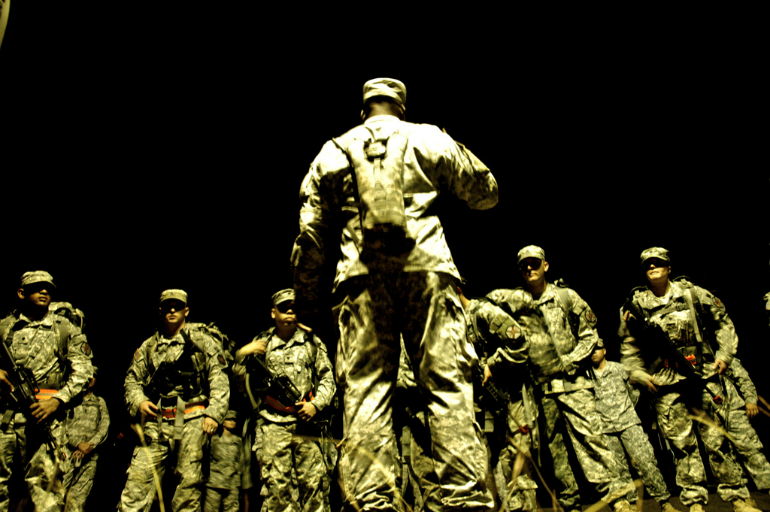The Army Needs a Better Argument

Admiral Gary Roughead and I wrote an alternative defense budget last year, arguing that our nation could be well defended within the Budget Control Act top line if the DoD was given the latitude to manage its money better. We believed that initiating reforms in procurement practices and personnel costs, as well as aligning spending to the DoD strategy would produce a radically different force—one that is both strategically sound and more affordable—because current costs are making our all-volunteer force unsustainable.
Most of the reaction to our proposals focused on cuts to active duty Army end strength. We did take a huge whack at it, cutting from the fiscal year 2013 proposal of 490,000 soldiers down to 290,000. To get to that number, we shifted 100,000 soldiers from the active to reserve component and disaggregated the land force roles and missions of the Army and Marine Corps. In our proposed force structure, the Army would concentrate on sustained land warfare. We required the Marine Corps (which we also cut, from 182,000 to 172,000) to accept significantly more risk in being the initial entry force in most contingencies.
In defending its force structure proposals, Army leadership has taken a dramatically different approach. It has argued that the dangers of the current international order require faster closing times for deploying land forces. To pick up on Robert Killabrew’s terrific analysis, the Army has made a strategic choice to optimize to deployment speed rather than sustainability. In short, after a decade of complaining about the Marine Corps trying to become the Army, the Army is now trying to become the Marine Corps.
There are lots of legitimate reasons to object to the end strength numbers Gary Roughead and I proposed, but the Army hasn’t offered many. What they have offered, through General Bill Hix and Colonel Bob Simpson, is ad hominem criticism (“This is a proposal that should raise the hair on the neck of any defense expert with a modicum of historical perspective and an understanding of the emerging 21st-century security environment”) followed by a straw man as they accuse anyone who would cut the Army of not believing in land wars.
What Army leaders have not provided is an adequate argument for retaining active duty end strength of 490,000. The rebuttal to the Army’s argument is: we believe our country will be fighting land wars, but the experience of the past decade has made our political leadership unwilling to fight them in the way you are planning and envisioning. The advocates of counterinsurgency won the war and lost the argument; we will fight small wars by sub-optimal standoff strikes and small training and operational engagements (and improving our homeland defenses).
What is the big war that necessitates such a large Army? According to press reports, The United States Army Training and Doctrine Command (TRADOC) envisions a requirement to deploy 530,000 soldiers to North Korea after that government collapses, with a closing time of six months. Imagine if you will, the Obama cabinet debating that proposal. No doubt, the administration would conclude that a better option would be to have the South Koreans oversee the occupation while we focus on trying to get teams in fast to control the nuclear weapons. Controlling the territory just won’t be a strategic objective that politicians are willing to adopt again for a very long time. The Army needs to take some ownership for the fact that the way we have fought these most recent wars is what is casting that long shadow.
Both of those considerations come even before the affordability question. General Odierno recently testified that the cost of a soldier has doubled since 2001 and is set to double again by 2025And he says that with an Army of 450,000 he cannot win one war, much less meet the demands for forces in the strategy. How exactly does the Army envision supporting so expensive a soldiery? Where are the trade-offs that any economist would say such a distribution of capital and labor should drive?
The Army seems actually to be cutting in a different direction than the President’s National Security Strategy and the Secretary of Defense’s Strategic Guidance, both of which explicitly state that ground forces will not be sized to fight a sustained (e.g., Iraq and Afghanistan) war going forward. Inattention from the senior civilian leadership so far to that divergence isn’t a reliable means of preserving end-strength.
Until the Army can come up with more innovative answers, it won’t be able to establish a floor under its end strength. And prioritizing rapid deployment capability isn’t sufficient justification for the Army’s end strength proposal. Even if they could flow 530,000 soldiers to North Korea in three weeks, no political leader is going to make the choice in favor of that option anytime soon. What is needed is greater intellectual ferment in TRADOC, and the Army more broadly, to fashion force structure and intervention options that can meet the policy guidelines properly established by the political leadership.
In particular, the Army ought to make a clear case for what is needed in the active component and what can be shifted to the reserve component. Guardsmen and reservists folded into the regular rotation and fought admirably these past ten years, why can they not now be entrusted with mobilizing quickly as large land war threats materialize? The timelines for such an eventuality make it possible. The economics of it make it tempting. It will be the default solution unless the Army innovates its way out of the problem.
The Army is fighting a budget battle by pretending it’s fighting a strategy battle. It’s not.
Kori Schake, Ph.D. is a fellow at Stanford University’s Hoover Institution. She formerly worked in the Departments of Defense and State, was the director of defense strategy and requirements on the NSC, and held the distinguished chair in international security studies at West Point.
Image: U.S. Army

